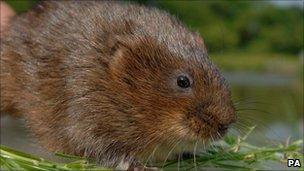New ponds 'attract' rare wildlife
- Published

Water voles have appeared in the newly created ponds
New freshwater ponds in England and Wales are having a positive impact on wildlife, the Environment Agency says.
The regulator is involved in charity Pond Conservation's plan to replace or restore 500,000 ponds said to have been lost in the UK in past century.
It says biodiversity has rapidly improved in the 234 ponds it has worked on so far this year.
Some 80 threatened species of aquatic insects, amphibians and plants are said to rely on the ponds for survival.
Wildlife including water voles, natterjack toads and great crested newts have all been spotted in the new ponds, the Environment Agency said.
The toothed threadwort, tadpole shrimp and one-grooved diving beetle should all be among the species to benefit from the creation of so much habitat, it added.
The Environment Agency says it will work with other organisations including the Wildlife Trusts and the National Trust to create new ponds every year, despite the current pressure on public finances.
'Instant gratification'
The Million Ponds Project aims to see number of ponds back up around the million mark, last seen 100 years ago.
As part of the scheme, the Environment Agency has this year created 184 ponds and restored a further 50 that were in poor condition.
The work included the creation of more than 30 ponds in a previously contaminated landscape at the former Wheal Jane tin mine near Truro, Cornwall.
Lord Chris Smith, chairman of the Environment Agency, said: "Halting the loss" of "precious native species is a huge challenge, and an urgent one".
He added: "Ponds are incredibly important for hundreds of plants and animals, and also help absorb carbon dioxide from the atmosphere.
"They are remarkably easy to create and, done in the right way, they will provide almost instant gratification as they quickly become very valuable habitats, supporting a wide range of species."
The Environment Agency has also suggested that this year's dry weather and low water levels in ponds presents an opportunity to clear out invasive plants and excess silt to encourage more wildlife.